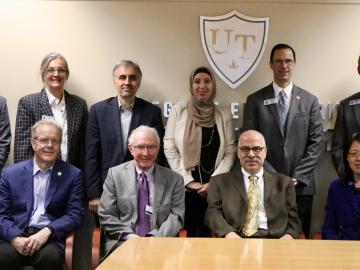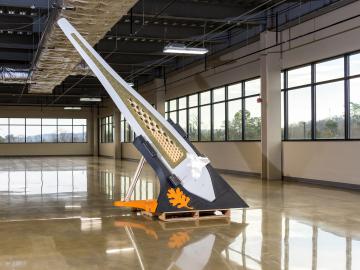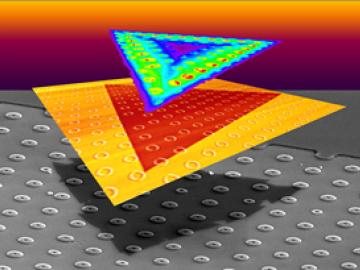
Filter News
Area of Research
- (-) Materials (49)
- (-) Supercomputing (93)
- Advanced Manufacturing (22)
- Biological Systems (1)
- Biology and Environment (44)
- Building Technologies (1)
- Computational Biology (2)
- Computational Engineering (1)
- Computer Science (5)
- Electricity and Smart Grid (3)
- Energy Science (128)
- Functional Materials for Energy (1)
- Fusion and Fission (10)
- Fusion Energy (2)
- Isotope Development and Production (1)
- Isotopes (10)
- Materials for Computing (9)
- National Security (27)
- Neutron Science (31)
- Nuclear Science and Technology (12)
- Quantum information Science (9)
- Sensors and Controls (1)
News Topics
- (-) 3-D Printing/Advanced Manufacturing (26)
- (-) Biomedical (22)
- (-) Cybersecurity (8)
- (-) Frontier (32)
- (-) Grid (9)
- (-) Quantum Science (33)
- (-) Simulation (16)
- (-) Space Exploration (5)
- Advanced Reactors (5)
- Artificial Intelligence (39)
- Big Data (22)
- Bioenergy (18)
- Biology (14)
- Biotechnology (2)
- Buildings (8)
- Chemical Sciences (32)
- Clean Water (3)
- Composites (9)
- Computer Science (99)
- Coronavirus (17)
- Critical Materials (15)
- Energy Storage (37)
- Environment (35)
- Exascale Computing (26)
- Fusion (8)
- High-Performance Computing (45)
- Irradiation (1)
- Isotopes (14)
- ITER (1)
- Machine Learning (15)
- Materials (79)
- Materials Science (83)
- Mathematics (2)
- Microscopy (29)
- Molten Salt (3)
- Nanotechnology (42)
- National Security (8)
- Neutron Science (42)
- Nuclear Energy (20)
- Partnerships (11)
- Physics (34)
- Polymers (18)
- Quantum Computing (21)
- Security (7)
- Software (1)
- Summit (43)
- Transportation (19)
Media Contacts

ORNL and The University of Toledo have entered into a memorandum of understanding for collaborative research.

The type of vehicle that will carry people to the Red Planet is shaping up to be “like a two-story house you’re trying to land on another planet.

Using additive manufacturing, scientists experimenting with tungsten at Oak Ridge National Laboratory hope to unlock new potential of the high-performance heat-transferring material used to protect components from the plasma inside a fusion reactor. Fusion requires hydrogen isotopes to reach millions of degrees.

Using the Titan supercomputer at Oak Ridge National Laboratory, a team of astrophysicists created a set of galactic wind simulations of the highest resolution ever performed. The simulations will allow researchers to gather and interpret more accurate, detailed data that elucidates how galactic winds affect the formation and evolution of galaxies.

In the shifting landscape of global manufacturing, American ingenuity is once again giving U.S companies an edge with radical productivity improvements as a result of advanced materials and robotic systems developed at the Department of Energy’s Manufacturing Demonstration Facility (MDF) at Oak Ridge National Laboratory.

A team led by scientists at the Department of Energy’s Oak Ridge National Laboratory explored how atomically thin two-dimensional (2D) crystals can grow over 3D objects and how the curvature of those objects can stretch and strain the

OAK RIDGE, Tenn., May 7, 2019—Energy Secretary Rick Perry, Congressman Chuck Fleischmann and lab officials today broke ground on a multipurpose research facility that will provide state-of-the-art laboratory space

OAK RIDGE, Tenn., May 7, 2019—The U.S. Department of Energy today announced a contract with Cray Inc. to build the Frontier supercomputer at Oak Ridge National Laboratory, which is anticipated to debut in 2021 as the world’s most powerful computer with a performance of greater than 1.5 exaflops.

Using artificial neural networks designed to emulate the inner workings of the human brain, deep-learning algorithms deftly peruse and analyze large quantities of data. Applying this technique to science problems can help unearth historically elusive solutions.

OAK RIDGE, Tenn., March 4, 2019—A team of researchers from the Department of Energy’s Oak Ridge National Laboratory Health Data Sciences Institute have harnessed the power of artificial intelligence to better match cancer patients with clinical trials.


